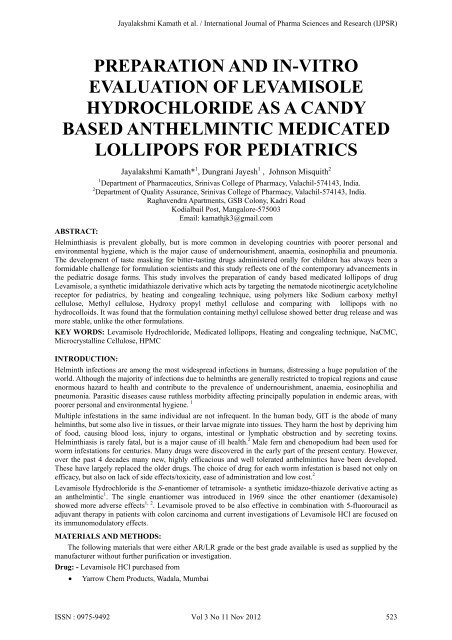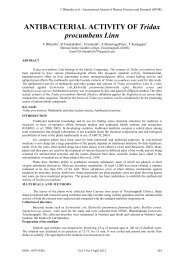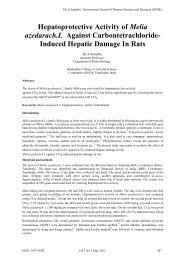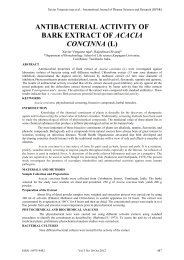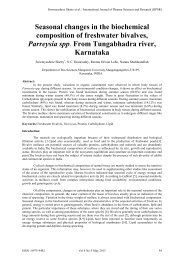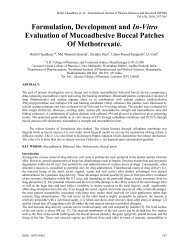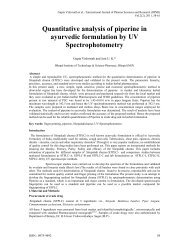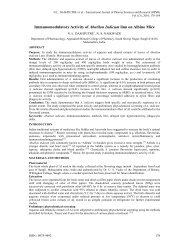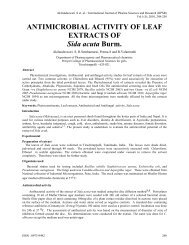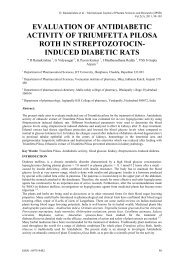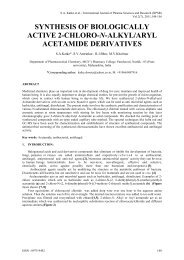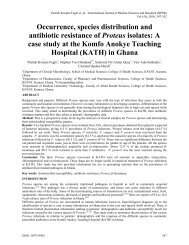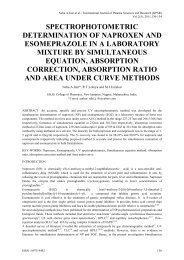preparation and in-vitro evaluation of levamisole hydrochloride as a ...
preparation and in-vitro evaluation of levamisole hydrochloride as a ...
preparation and in-vitro evaluation of levamisole hydrochloride as a ...
Create successful ePaper yourself
Turn your PDF publications into a flip-book with our unique Google optimized e-Paper software.
Jayalakshmi Kamath et al. / International Journal <strong>of</strong> Pharma Sciences <strong>and</strong> Research (IJPSR)<br />
PREPARATION AND IN-VITRO<br />
EVALUATION OF LEVAMISOLE<br />
HYDROCHLORIDE AS A CANDY<br />
BASED ANTHELMINTIC MEDICATED<br />
LOLLIPOPS FOR PEDIATRICS<br />
Jayalakshmi Kamath* 1 , Dungrani Jayesh 1 , Johnson Misquith 2<br />
1 Department <strong>of</strong> Pharmaceutics, Sr<strong>in</strong>iv<strong>as</strong> College <strong>of</strong> Pharmacy, Valachil-574143, India.<br />
2 Department <strong>of</strong> Quality Assurance, Sr<strong>in</strong>iv<strong>as</strong> College <strong>of</strong> Pharmacy, Valachil-574143, India.<br />
Raghavendra Apartments, GSB Colony, Kadri Road<br />
Kodialbail Post, Mangalore-575003<br />
Email: kamathjk3@gmail.com<br />
ABSTRACT:<br />
Helm<strong>in</strong>thi<strong>as</strong>is is prevalent globally, but is more common <strong>in</strong> develop<strong>in</strong>g countries with poorer personal <strong>and</strong><br />
environmental hygiene, which is the major cause <strong>of</strong> undernourishment, anaemia, eos<strong>in</strong>ophilia <strong>and</strong> pneumonia.<br />
The development <strong>of</strong> t<strong>as</strong>te m<strong>as</strong>k<strong>in</strong>g for bitter-t<strong>as</strong>t<strong>in</strong>g drugs adm<strong>in</strong>istered orally for children h<strong>as</strong> always been a<br />
formidable challenge for formulation scientists <strong>and</strong> this study reflects one <strong>of</strong> the contemporary advancements <strong>in</strong><br />
the pediatric dosage forms. This study <strong>in</strong>volves the <strong>preparation</strong> <strong>of</strong> c<strong>and</strong>y b<strong>as</strong>ed medicated lollipops <strong>of</strong> drug<br />
Levamisole, a synthetic imidathiazole derivative which acts by target<strong>in</strong>g the nematode nicot<strong>in</strong>ergic acetylchol<strong>in</strong>e<br />
receptor for pediatrics, by heat<strong>in</strong>g <strong>and</strong> congeal<strong>in</strong>g technique, us<strong>in</strong>g polymers like Sodium carboxy methyl<br />
cellulose, Methyl cellulose, Hydroxy propyl methyl cellulose <strong>and</strong> compar<strong>in</strong>g with lollipops with no<br />
hydrocolloids. It w<strong>as</strong> found that the formulation conta<strong>in</strong><strong>in</strong>g methyl cellulose showed better drug rele<strong>as</strong>e <strong>and</strong> w<strong>as</strong><br />
more stable, unlike the other formulations.<br />
KEY WORDS: Levamisole Hydrochloride, Medicated lollipops, Heat<strong>in</strong>g <strong>and</strong> congeal<strong>in</strong>g technique, NaCMC,<br />
Microcrystall<strong>in</strong>e Cellulose, HPMC<br />
INTRODUCTION:<br />
Helm<strong>in</strong>th <strong>in</strong>fections are among the most widespread <strong>in</strong>fections <strong>in</strong> humans, distress<strong>in</strong>g a huge population <strong>of</strong> the<br />
world. Although the majority <strong>of</strong> <strong>in</strong>fections due to helm<strong>in</strong>ths are generally restricted to tropical regions <strong>and</strong> cause<br />
enormous hazard to health <strong>and</strong> contribute to the prevalence <strong>of</strong> undernourishment, anaemia, eos<strong>in</strong>ophilia <strong>and</strong><br />
pneumonia. Par<strong>as</strong>itic dise<strong>as</strong>es cause ruthless morbidity affect<strong>in</strong>g pr<strong>in</strong>cipally population <strong>in</strong> endemic are<strong>as</strong>, with<br />
poorer personal <strong>and</strong> environmental hygiene. 1<br />
Multiple <strong>in</strong>festations <strong>in</strong> the same <strong>in</strong>dividual are not <strong>in</strong>frequent. In the human body, GIT is the abode <strong>of</strong> many<br />
helm<strong>in</strong>ths, but some also live <strong>in</strong> tissues, or their larvae migrate <strong>in</strong>to tissues. They harm the host by depriv<strong>in</strong>g him<br />
<strong>of</strong> food, caus<strong>in</strong>g blood loss, <strong>in</strong>jury to organs, <strong>in</strong>test<strong>in</strong>al or lymphatic obstruction <strong>and</strong> by secret<strong>in</strong>g tox<strong>in</strong>s.<br />
Helm<strong>in</strong>thi<strong>as</strong>is is rarely fatal, but is a major cause <strong>of</strong> ill health. 2 Male fern <strong>and</strong> chenopodium had been used for<br />
worm <strong>in</strong>festations for centuries. Many drugs were discovered <strong>in</strong> the early part <strong>of</strong> the present century. However,<br />
over the p<strong>as</strong>t 4 decades many new, highly efficacious <strong>and</strong> well tolerated anthelm<strong>in</strong>tics have been developed.<br />
These have largely replaced the older drugs. The choice <strong>of</strong> drug for each worm <strong>in</strong>festation is b<strong>as</strong>ed not only on<br />
efficacy, but also on lack <strong>of</strong> side effects/toxicity, e<strong>as</strong>e <strong>of</strong> adm<strong>in</strong>istration <strong>and</strong> low cost. 2<br />
Levamisole Hydrochloride is the S-enantiomer <strong>of</strong> tetramisole- a synthetic imidazo-thiazole derivative act<strong>in</strong>g <strong>as</strong><br />
an anthelm<strong>in</strong>tic 1 . The s<strong>in</strong>gle enantiomer w<strong>as</strong> <strong>in</strong>troduced <strong>in</strong> 1969 s<strong>in</strong>ce the other enantiomer (dexamisole)<br />
showed more adverse effects 1, 2 . Levamisole proved to be also effective <strong>in</strong> comb<strong>in</strong>ation with 5-fluorouracil <strong>as</strong><br />
adjuvant therapy <strong>in</strong> patients with colon carc<strong>in</strong>oma <strong>and</strong> current <strong>in</strong>vestigations <strong>of</strong> Levamisole HCl are focused on<br />
its immunomodulatory effects.<br />
MATERIALS AND METHODS:<br />
The follow<strong>in</strong>g materials that were either AR/LR grade or the best grade available is used <strong>as</strong> supplied by the<br />
manufacturer without further purification or <strong>in</strong>vestigation.<br />
Drug: - Levamisole HCl purch<strong>as</strong>ed from<br />
• Yarrow Chem Products, Wadala, Mumbai<br />
ISSN : 0975-9492 Vol 3 No 11 Nov 2012 523
Jayalakshmi Kamath et al. / International Journal <strong>of</strong> Pharma Sciences <strong>and</strong> Research (IJPSR)<br />
Polymers:<br />
Table No.1 List <strong>of</strong> Polymers<br />
Sl. Name Grade Supplier<br />
1. Methyl Cellulose Pharma<br />
Grade<br />
2. Sodium carboxy methyl cellulose Pharma<br />
Grade<br />
Yarrow Chem Products<br />
Himedia<br />
3. Hydroxy propyl methyl cellulose Pharma<br />
Grade<br />
Yarrow Chem Products<br />
Other Materials:<br />
Table No.2 List <strong>of</strong> Excipients<br />
Sl.<br />
No.<br />
Name<br />
Suppliers<br />
1. Sucrose Himedia<br />
2. Dextrose Yarrow Chem Products<br />
3. Citric acid Yarrow Chem Products<br />
EXPERIMENTAL:<br />
FORMULATION OF MEDICATED LOLLIPOPS<br />
Preparation <strong>of</strong> Medicated lollipops by Heat<strong>in</strong>g <strong>and</strong> congeal<strong>in</strong>g method 44<br />
Medicated lollipops 5gms <strong>in</strong> weight oval <strong>in</strong> shape were prepared. The method followed for the <strong>preparation</strong> w<strong>as</strong><br />
heat<strong>in</strong>g <strong>and</strong> congeal<strong>in</strong>g technique. Syrup b<strong>as</strong>e w<strong>as</strong> prepared <strong>in</strong> a copper vessel dissolv<strong>in</strong>g the required amounts<br />
<strong>of</strong> sugar <strong>in</strong> water on heat<strong>in</strong>g <strong>and</strong> stirr<strong>in</strong>g cont<strong>in</strong>ued for 2 hours by rais<strong>in</strong>g the temperature to 160 0 C.The<br />
temperature w<strong>as</strong> brought down 90 0 C till a pl<strong>as</strong>tic m<strong>as</strong>s w<strong>as</strong> obta<strong>in</strong>ed. Drug, polymer, color, flavor were added<br />
<strong>and</strong> mixed the material for 30m<strong>in</strong>. The mixture w<strong>as</strong> poured <strong>in</strong>to the molds. Air dried for 2 hours. The prepared<br />
lollipops were seal wrapped <strong>in</strong> polythene wrapp<strong>in</strong>gs. An altogether three batches <strong>of</strong> formulations were prepared<br />
i.e., without added hydrocolloid, methylcellulose (MC) added, HPMC (Hydroxy propyl methyl cellulose,<br />
Sodium Carboxy methyl cellulose added medicated lollipops.<br />
EVALUATION OF MEDICATED LOLLIPOPS<br />
Evaluation:<br />
1) Drug Content:<br />
The drug content w<strong>as</strong> calculated for all the six formulations <strong>of</strong> Medicated lollipops. Table No.15 <strong>and</strong> Fig No.12<br />
shows the result <strong>of</strong> drug content <strong>of</strong> each formulation. Three replication <strong>of</strong> each test were analyzed for mean <strong>and</strong><br />
st<strong>and</strong>ard deviation. The drug content found <strong>in</strong> the formulations conta<strong>in</strong><strong>in</strong>g methyl cellulose i.e., F1 <strong>and</strong> F2<br />
conta<strong>in</strong>s 100.24±0.05 <strong>and</strong> 101.56±0.12% <strong>of</strong> the drug respectively, which <strong>in</strong>dicates drug content <strong>in</strong> F1< F2. The<br />
drug content <strong>in</strong> the formulations F3 <strong>and</strong> F4 conta<strong>in</strong><strong>in</strong>g polymer Sodium carboxy methyl cellulose conta<strong>in</strong>s<br />
100.24±0.10 <strong>and</strong> 99.36±0.08% respectively which implies drug content <strong>in</strong> F3> F4. Among the formulations the<br />
highest percentage <strong>of</strong> drug w<strong>as</strong> <strong>in</strong> F2 <strong>and</strong> the lowest be<strong>in</strong>g F4. The formulation without Hydrocolloids i.e., F0<br />
conta<strong>in</strong> 99.68±0.06% <strong>of</strong> drug. Hence, all the formulations were found to be with<strong>in</strong> the st<strong>and</strong>ard limits, which<br />
states that the drug content should be <strong>in</strong> the range <strong>of</strong> 95%- 105% for Levamisole.<br />
2) Weight variation:<br />
20 <strong>in</strong>dividual lollipops <strong>of</strong> F0 to F4 formulations were weighed; mean <strong>and</strong> st<strong>and</strong>ard deviation were calculated for<br />
ISSN : 0975-9492 Vol 3 No 11 Nov 2012 524
Jayalakshmi Kamath et al. / International Journal <strong>of</strong> Pharma Sciences <strong>and</strong> Research (IJPSR)<br />
each Table No.15 shows the mean value <strong>of</strong> uniformity <strong>of</strong> weight. The formulation F1 <strong>and</strong> F2 conta<strong>in</strong><strong>in</strong>g Methyl<br />
cellulose weighed 5.13±0.04gm <strong>and</strong> 5.18±0.09gms respectively, hence weight variation <strong>in</strong> F1< F2. The<br />
formulation conta<strong>in</strong><strong>in</strong>g Sodium carboxy methyl cellulose F3 <strong>and</strong> F4 weighs 5.16±0.06gms <strong>and</strong> 5.22±0.08gms<br />
respectively, hence weight variation <strong>in</strong> F3< F4. The highest weigh<strong>in</strong>g formulation is F2 <strong>and</strong> lowest F1. The<br />
formulation conta<strong>in</strong><strong>in</strong>g no hydrocolloids weighs 5.07±0.02gms.<br />
3) Thickness:<br />
The thickness <strong>of</strong> the lollipops (F0 to F4) were me<strong>as</strong>ured by us<strong>in</strong>g Vernier calipers by select<strong>in</strong>g five lollipops <strong>in</strong><br />
r<strong>and</strong>om. The mean values are shown <strong>in</strong> Table No.15.The values were almost uniform <strong>in</strong> four formulations i.e.,<br />
F0, F1, F2, F3, <strong>and</strong> F4 <strong>and</strong> it w<strong>as</strong> found to vary between 10.01±0.08mm to 10.61±0.005mm which w<strong>as</strong> found <strong>in</strong><br />
F0 <strong>and</strong> F4 respectively.<br />
4) Hardness:<br />
The hardness <strong>of</strong> the lollipops (F0 to F4) were me<strong>as</strong>ured by Monsanto Hardness Tester by select<strong>in</strong>g six lollipops<br />
<strong>of</strong> each formulation <strong>in</strong> r<strong>and</strong>om. The highest hardness w<strong>as</strong> found <strong>in</strong> formulation F4 i.e., 10.11±0.006kg/cm 2 <strong>and</strong><br />
le<strong>as</strong>t hardness w<strong>as</strong> determ<strong>in</strong>ed <strong>in</strong> F5 i.e., 9.21±0.005kg/cm 2 . S<strong>in</strong>ce there is no specified st<strong>and</strong>ard limits for the<br />
deviation <strong>in</strong> the hardness <strong>of</strong> lollipops, compar<strong>in</strong>g each formulation with one another it could be concluded that,<br />
because the difference between the st<strong>and</strong>ard deviations are not too large, the formulations had good uniformity<br />
<strong>in</strong> the hardness.<br />
5) In-<strong>vitro</strong> rele<strong>as</strong>e studies:<br />
All the six formulation prepared were subjected to <strong>in</strong>-<strong>vitro</strong> rele<strong>as</strong>e study. The <strong>in</strong>-<strong>vitro</strong> method for study<strong>in</strong>g the<br />
rele<strong>as</strong>e rate should be so that it must simulate the mouth condition. In the present work <strong>in</strong>-<strong>vitro</strong> rele<strong>as</strong>e study<br />
w<strong>as</strong> carried out us<strong>in</strong>g dissolution apparatus. For different time <strong>in</strong>terval, sample w<strong>as</strong> withdrawn <strong>and</strong> cumulative<br />
drug rele<strong>as</strong>e w<strong>as</strong> calculated. The dissolution apparatus USP II paddle type w<strong>as</strong> used. The temperature w<strong>as</strong><br />
ma<strong>in</strong>ta<strong>in</strong>ed at 37± 0.5 0 C <strong>and</strong> stirred at 100rpm. The dissolution medium be<strong>in</strong>g phosphate buffer <strong>of</strong> pH 6.8. The<br />
samples were withdrawn at 5m<strong>in</strong>s <strong>in</strong>terval for 30m<strong>in</strong>s.<br />
S<strong>in</strong>ce the drug rele<strong>as</strong>e <strong>in</strong> the formulations F0, F1, F2 were f<strong>as</strong>ter the samples were withdrawn at 2m<strong>in</strong>s <strong>in</strong>terval.<br />
And for F3, <strong>and</strong> F4 the samples were withdrawn at 5m<strong>in</strong>s <strong>in</strong>terval. Cumulative percentage drug rele<strong>as</strong>e <strong>and</strong><br />
percentage drug reta<strong>in</strong>ed unrele<strong>as</strong>ed were calculated on the b<strong>as</strong>is <strong>of</strong> mean amount <strong>of</strong> Levamisole Hydrochloride<br />
present <strong>in</strong> the respective lollipops. The results are given <strong>in</strong> Table No: 16 to 22 <strong>and</strong> Fig. No: 12 <strong>and</strong> 13.<br />
The cumulative percentage drug rele<strong>as</strong>e <strong>of</strong> F1 at the end <strong>of</strong> 12 m<strong>in</strong>utes w<strong>as</strong> found to be 99.08036±0.78% <strong>and</strong> F2<br />
98.764±0.88 at the end <strong>of</strong> 14 m<strong>in</strong>utes. The rele<strong>as</strong>e w<strong>as</strong> f<strong>as</strong>ter <strong>in</strong> F1 than F2. The cumulative percentage drug<br />
rele<strong>as</strong>e <strong>of</strong> F3 w<strong>as</strong> 99.687±0.23% by the end <strong>of</strong> 20m<strong>in</strong>s <strong>and</strong> <strong>in</strong> F4 98.748±0.11 at 25m<strong>in</strong>s.<br />
Hence by the determ<strong>in</strong>ation <strong>of</strong> the <strong>in</strong>-<strong>vitro</strong> rele<strong>as</strong>e data, it can be concluded that the drug rele<strong>as</strong>e w<strong>as</strong> f<strong>as</strong>ter <strong>in</strong><br />
c<strong>as</strong>e <strong>of</strong> F1 <strong>and</strong> F2 which w<strong>as</strong> with<strong>in</strong> 15m<strong>in</strong>s. The formulations conta<strong>in</strong><strong>in</strong>g Sodium carboxy methyl cellulose <strong>and</strong><br />
Hydroxy propyl methyl cellulose showed slower rele<strong>as</strong>e rates when compared to Methyl cellulose. The use <strong>of</strong><br />
polymers showed extended rele<strong>as</strong>e <strong>of</strong> the drug.<br />
This shows that F1 <strong>and</strong> F2 have comparatively moderate time <strong>of</strong> rele<strong>as</strong>e, than the other formulations which<br />
shows longer time <strong>of</strong> rele<strong>as</strong>e <strong>in</strong> comparison to F1 <strong>and</strong> F2, which can be considered <strong>as</strong> a desirable characteristic<br />
for the <strong>preparation</strong> <strong>of</strong> medicated lollipops. Hence it is considered <strong>as</strong> preferred formulations.<br />
RESULTS AND DISCUSSION:<br />
Several methods were described <strong>in</strong> the previous chapter for the formulation <strong>and</strong> <strong>evaluation</strong> <strong>of</strong> c<strong>and</strong>y b<strong>as</strong>ed<br />
medicated lollipops. These lollipops were <strong>in</strong>tended for the treatment <strong>of</strong> anthelm<strong>in</strong>tic. The lollipops were prepared<br />
<strong>as</strong> per the procedures <strong>and</strong> formulated accord<strong>in</strong>g to the formul<strong>as</strong> given <strong>in</strong> Table No.13. The prepared lollipops were<br />
then subjected to <strong>evaluation</strong> like <strong>in</strong>-<strong>vitro</strong> dissolution studies, hardness, thickness, weight variation, stability studies<br />
<strong>and</strong> compatibility studies. The procedure adopted to perform the above mentioned parameters were discussed <strong>in</strong><br />
methodology section <strong>and</strong> the obta<strong>in</strong>ed data were shown <strong>in</strong> results section.<br />
Identification <strong>of</strong> max<br />
The drug w<strong>as</strong> identified by the light absorption <strong>in</strong> the UV range <strong>of</strong> 400-200nm at max 215nm. This w<strong>as</strong> <strong>in</strong><br />
accordance with reported values. The result were shown <strong>in</strong> Fig.No.3<br />
St<strong>and</strong>ard curve for Levamisole:<br />
Table No:6 shows the absorbance <strong>of</strong> Levamisole st<strong>and</strong>ard solution conta<strong>in</strong><strong>in</strong>g 2,4,6,8 <strong>and</strong> 10 mg/ml <strong>of</strong> drug <strong>in</strong><br />
pH 6.8 phosphate buffer solution. Fig No:4 shows the st<strong>and</strong>ard calibration curve with the correlation coefficient<br />
<strong>of</strong> 0.996 <strong>and</strong> regression value <strong>of</strong> Y=+0.028 the calculation <strong>of</strong> drug content uniformity <strong>in</strong>-<strong>vitro</strong> dilution studies<br />
are b<strong>as</strong>ed on this calibration curve.<br />
Drug-Excipient Compatibility studies:<br />
The IR spectra <strong>of</strong> the formulation w<strong>as</strong> compared with the st<strong>and</strong>ard spectrum <strong>of</strong> pure drug Levamisole<br />
ISSN : 0975-9492 Vol 3 No 11 Nov 2012 525
Jayalakshmi Kamath et al. / International Journal <strong>of</strong> Pharma Sciences <strong>and</strong> Research (IJPSR)<br />
Hydrochloride <strong>and</strong> the characteristic absorption peaks <strong>as</strong>sociated with specific functional groups <strong>and</strong> bonds <strong>of</strong><br />
the molecule <strong>and</strong> their presence <strong>of</strong> absence <strong>in</strong> the excipients were noted. The prom<strong>in</strong>ent peaks <strong>as</strong>sociated with<br />
Aromatic stretch<strong>in</strong>g, N-H am<strong>in</strong>e stretch<strong>in</strong>g <strong>and</strong> C-N vibrations <strong>of</strong> Levamisole Hydrochloride were obta<strong>in</strong>ed<br />
(alone <strong>and</strong> with different polymer) were analyzed.<br />
The pr<strong>in</strong>ciple IR absorption peak <strong>of</strong> Levamisole Hydrochloride <strong>and</strong> all excipients are <strong>as</strong> follows:<br />
• The peak at 2791.46 cm -1 , 2883.06 cm -1 , 2955.38 cm -1 , 2882.09 cm -1 <strong>and</strong> 2955.38cm -1 <strong>in</strong> drug, drug +<br />
methylcellulose, drug + NaCMC, drug , drug+ excipients respectively is due to aromatic stretch<strong>in</strong>g.<br />
• The peak at 1516.74 cm -1 , 1566.88 cm -1 , 1567.84 cm -1 , 1568.88 cm -1 <strong>and</strong> 1566.88 cm -1 drug, drug +<br />
methylcellulose, drug + NaCMC, drug, drug+ excipients respectively is due to N-H am<strong>in</strong>e stretch<strong>in</strong>g.<br />
• The peak at 1088.62 cm -1 , 1040.41 cm -1 , 1078.99 cm -1 , 1028.84 cm -1 <strong>and</strong> 1078.98 cm -1 drug, drug +<br />
methylcellulose, drug +NaCMC, drug, drug+ excipients respectively is due to C-N vibrations.<br />
The range <strong>of</strong> peak values were found to be the same <strong>in</strong>dicat<strong>in</strong>g that there were no <strong>in</strong>teraction <strong>of</strong> Levamisole<br />
Hydrochloride with different polymer confirm<strong>in</strong>g the stability <strong>of</strong> drug <strong>in</strong> the formulation. The spectra for all the<br />
three polymer along with the drug are shown from Fig No: 6, Fig.No:7, Fig No:8 <strong>and</strong> Fig No.9. The spectra for<br />
drug Levamisole Hydrochloride, is shown <strong>in</strong> Fig No: 5 <strong>and</strong> the peak pick<strong>in</strong>gs <strong>in</strong> the spectra are shown <strong>in</strong><br />
Table.No:7, 8, 9, 10 <strong>and</strong> 11.<br />
CONCLUSION:<br />
In the present study, an attempt w<strong>as</strong> made to formulate <strong>and</strong> evaluate c<strong>and</strong>y b<strong>as</strong>ed medicated lollipops <strong>of</strong><br />
Levamisole Hydrochloride for the treatment <strong>of</strong> Helm<strong>in</strong>ths. The ma<strong>in</strong> <strong>in</strong>terest <strong>in</strong> such a dosage form w<strong>as</strong> for the<br />
development <strong>of</strong> new dosage form <strong>and</strong> the effect <strong>of</strong> different polymers on the <strong>in</strong>-<strong>vitro</strong> rele<strong>as</strong>e <strong>of</strong> the drug <strong>and</strong> also<br />
their stability. At the outset, estimation <strong>of</strong> drug by UV visible spectrophotometer w<strong>as</strong> carried out. The possible<br />
<strong>in</strong>teraction between the drug <strong>and</strong> excipient w<strong>as</strong> studied by FT-IR spectroscopy which showed that there w<strong>as</strong> no<br />
<strong>in</strong>teraction between the selected drug <strong>and</strong> polymers under study.<br />
C<strong>and</strong>y b<strong>as</strong>ed medicated lollipops <strong>of</strong> Levamisole Hydrochloride w<strong>as</strong> prepared by Heat<strong>in</strong>g <strong>and</strong> congeal<strong>in</strong>g<br />
method. In this study, various formulations were developed us<strong>in</strong>g Methyl cellulose, Sodium carboxy methyl<br />
cellulose. Evaluation parameters like thickness, weight variation, hardness show that they were with<strong>in</strong> the limits.<br />
Drug content uniformity w<strong>as</strong> also found to be with<strong>in</strong> the limit. In <strong>vitro</strong> rele<strong>as</strong>e rate studies showed that the drug<br />
rele<strong>as</strong>e w<strong>as</strong> maximum <strong>in</strong> formulation F0 <strong>and</strong> m<strong>in</strong>imum <strong>in</strong> F4. The rate <strong>of</strong> rele<strong>as</strong>e <strong>of</strong> F1 <strong>and</strong> F2 w<strong>as</strong> found to be<br />
99.08% <strong>in</strong> 12 m<strong>in</strong>utes <strong>and</strong> 98.76% <strong>in</strong> 14m<strong>in</strong>s respectively. The rate <strong>of</strong> rele<strong>as</strong>e <strong>of</strong> F3 <strong>and</strong> F4 w<strong>as</strong> 99.68% at 20<br />
m<strong>in</strong>utes <strong>and</strong> F4 at 25 m<strong>in</strong>utes respectively. This shows that F1 <strong>and</strong> F2 have comparatively moderate time <strong>of</strong><br />
rele<strong>as</strong>e, than the other formulations which shows longer time <strong>of</strong> rele<strong>as</strong>e <strong>in</strong> comparison to F1 <strong>and</strong> F2, which is<br />
considered <strong>as</strong> a desirable characteristic for the <strong>preparation</strong> <strong>of</strong> medicated lollipops. Hence it is considered <strong>as</strong><br />
preferred formulations. All the formulations were found to be stable over the storage period <strong>and</strong> at different<br />
conditions tested.<br />
TABLES AND FIGURES<br />
Fig. No.1 UV visible spectrum for drug Levamisole<br />
ISSN : 0975-9492 Vol 3 No 11 Nov 2012 526
Jayalakshmi Kamath et al. / International Journal <strong>of</strong> Pharma Sciences <strong>and</strong> Research (IJPSR)<br />
Table No.3 St<strong>and</strong>ard Graph for Levamisole<br />
Concentration (µg/ml) Absorbance (nm) St<strong>and</strong>ard deviation (±)<br />
0 0 0<br />
2 0.058 0.006<br />
4 0.116 0.013<br />
6 0.165 0.034<br />
8 0.219 0.007<br />
10 0.295 0.011<br />
*Each value is an average <strong>of</strong> three determ<strong>in</strong>ations<br />
0.35<br />
0.3<br />
0.25<br />
y = 0.0285x<br />
R² = 0.9962<br />
0.2<br />
0.15<br />
Series1<br />
L<strong>in</strong>ear (Series1)<br />
0.1<br />
0.05<br />
0<br />
0 5 10 15<br />
Fig No: 2 St<strong>and</strong>ard Graph For Levamisole<br />
ISSN : 0975-9492 Vol 3 No 11 Nov 2012 527
Jayalakshmi Kamath et al. / International Journal <strong>of</strong> Pharma Sciences <strong>and</strong> Research (IJPSR)<br />
DRUG EXCIPIENT COMPATIBILITY STUDIES<br />
Fig. No: 3 FTIR for Pure Drug Levamisole<br />
Table No:4 Peak pick<strong>in</strong>g for pure drug Levamisole<br />
Sr no Position Intensity Sr no Position Intensity<br />
1 3647.7 52.3174 8 994.125 35.8179<br />
2 2791.46 24.6863 9 943.985 35.4752<br />
3 1996.93 44.4922 10 834.062 29.8879<br />
4 1516.74 25.5432 11 809.956 32.0644<br />
5 1248.68 26.1364 12 766.566 22.4368<br />
6 1088.62 40.0357 13 736.674 25.7771<br />
7 1065.48 37.4268 14 694.248 21.1318<br />
ISSN : 0975-9492 Vol 3 No 11 Nov 2012 528
Jayalakshmi Kamath et al. / International Journal <strong>of</strong> Pharma Sciences <strong>and</strong> Research (IJPSR)<br />
Fig.No:4 FTIR for pure drug+ Methyl cellulose<br />
Table No:5 Peak pick<strong>in</strong>g for pure drug <strong>and</strong> methylcellulose<br />
Sr no Position Intensity Sr no Position Intensity<br />
1 3743.15 66.6756 8 1040.41 31.1129<br />
2 3501.13 38.7003 9 870.703 36.1239<br />
3 2883.06 34.1172 10 830.205 42.5441<br />
4 2040.32 58.1972 11 800.314 32.9754<br />
5 1659.45 37.173 12 767.53 39.5872<br />
6 1566.88 37.5378 13 738.603 41.5979<br />
7 1102.12 30.0877 14 723.175 41.1332<br />
Fig.No:5 FTIR for pure drug + Sodium Carboxy methyl cellulose<br />
ISSN : 0975-9492 Vol 3 No 11 Nov 2012 529
Jayalakshmi Kamath et al. / International Journal <strong>of</strong> Pharma Sciences <strong>and</strong> Research (IJPSR)<br />
Table No:6 Peak pick<strong>in</strong>g for pure drug <strong>and</strong> Sodium carboxy methyl cellulose<br />
Sr no Position Intensity Sr no Position Intensity<br />
1 3290.93 22.9625 8 870.703 25.5148<br />
2 2955.38 23.781 9 801.278 24.1066<br />
3 2041.28 48.0189 10 720.282 12.0014<br />
4 1654.62 20.9484 11 668.214 23.0761<br />
5 1567.84 20.9902 12 577.576 18.1545<br />
6 1262.18 20.9485 13 519.722 22.3933<br />
7 1078.98 15.953 14 510.08 15.2858<br />
Fig. No: 6 FTIR for pure drug +All Excipients<br />
Table No:7 Peak pick<strong>in</strong>g for pure drug <strong>and</strong> all the excipients<br />
Sr no Position Intensity Sr no Position Intensity<br />
1 3290.93 27.7841 8 1039.44 25.5118<br />
2 2955.38 27.8301 9 980.625 28.3007<br />
3 2042.25 54.2802 10 870.703 31.2782<br />
4 1655.59 24.5373 11 801.278 30.3867<br />
5 1566.88 25.2557 12 720.282 16.0848<br />
ISSN : 0975-9492 Vol 3 No 11 Nov 2012 530
Jayalakshmi Kamath et al. / International Journal <strong>of</strong> Pharma Sciences <strong>and</strong> Research (IJPSR)<br />
Table No:8 Interpretation <strong>of</strong> FT-IR spectra <strong>of</strong> Pure drug <strong>and</strong> Polymer<br />
Ingredients<br />
Peaks <strong>of</strong> functional groups<br />
(cm-1)<br />
Aromatic<br />
stretch<strong>in</strong>g<br />
N-H Am<strong>in</strong>e<br />
stretch<strong>in</strong>g<br />
C-N<br />
vibrations<br />
Levamisole 2791.46 1516.74 1088.62<br />
Levamisole+MC 2883.06 1566.88 1040.41<br />
Levamisole+ NaCMC 2955.38 1567.84 1078.98<br />
Levamisole+Excipents 2955.38 1566.88 1078.98<br />
PREPARATION OF CANDY BASED MEDICATED LOLLIPOPS<br />
Table No:9 Formulation Chart for C<strong>and</strong>y b<strong>as</strong>ed Medicated Lollipops<br />
BATCH F0 F1 F2 F3 F4<br />
DRUG<br />
LEVAMISOLE 50mg 50mg 50mg 50mg 50mg<br />
SUCROSE<br />
3.52365<br />
gms<br />
3.4476<br />
gms<br />
3.37155<br />
gms<br />
3.4476<br />
Gms<br />
3.37155g<br />
ms<br />
DEXTROSE<br />
1.45002<br />
gms<br />
1.45002<br />
gms<br />
1.45002<br />
gms<br />
1.45002<br />
Gms<br />
1.45002g<br />
ms<br />
METHYL<br />
CELLULOSE<br />
0.0507<br />
gms<br />
0.07605<br />
gms<br />
- -<br />
SODIUM<br />
CARBOXY<br />
METHYL<br />
CELLULOSE<br />
CITRIC ACID<br />
- - -<br />
0.0507<br />
gms<br />
0.0507<br />
gms<br />
0.0507<br />
gms<br />
0.0507<br />
gms<br />
0.0507<br />
gms<br />
0.07605<br />
gms<br />
0.0507<br />
gms<br />
COLOURING<br />
AGENT q.s q.s q.s q.s q.s<br />
FLAVOURING<br />
AGENT<br />
0.0344<br />
gms<br />
0.0344<br />
gms<br />
0.0344<br />
gms<br />
0.0344<br />
gms<br />
0.0344<br />
gms<br />
ISSN : 0975-9492 Vol 3 No 11 Nov 2012 531
Jayalakshmi Kamath et al. / International Journal <strong>of</strong> Pharma Sciences <strong>and</strong> Research (IJPSR)<br />
Fig.No:7 Models <strong>of</strong> Prepared Medicated Lollipops II<br />
CHARACTERIZATION OF PREPARED MEDICATED LOLLIPOPS<br />
Table No: 10 Physical Appearance <strong>of</strong> prepared Medicated lollipops<br />
Formulation<br />
Appearance<br />
F0<br />
F1<br />
F2<br />
F3<br />
Orange, smooth, little sticky, e<strong>as</strong>ily removed from the<br />
mold<br />
Orange, smooth, little less sticky, e<strong>as</strong>ily removed<br />
from the mold<br />
Orange, smooth, little less sticky, e<strong>as</strong>ily removed<br />
from the mold<br />
Orange, smooth, sticky<br />
F4<br />
Orange, smooth, little sticky<br />
Table No: 11 Physicochemical Characterization <strong>of</strong> Medicated Lollipops<br />
Batch<br />
no.<br />
Weight<br />
Variation(gm)±SD<br />
Hardness(kg/cm 2 )<br />
±SD<br />
Thickness<br />
(mm)±SD<br />
Drug content<br />
(%) ±SD<br />
F0 5.07±0.02 9.30±0.06 10.01±0.08 99.68±0.06<br />
F1 5.13±0.04 9.56±0.07 10.11±0.08 100.24±0.05<br />
F2 5.18±0.09 9.84±0.09 10.21±0.05 101.56±0.12<br />
F3 5.16±0.06 10.05±0.03 10.56±0.09 100.24±0.10<br />
F4 5.22±0.08 10.11±0.06 10.50±0.02 99.36±0.08<br />
ISSN : 0975-9492 Vol 3 No 11 Nov 2012 532
Jayalakshmi Kamath et al. / International Journal <strong>of</strong> Pharma Sciences <strong>and</strong> Research (IJPSR)<br />
* Each value is an average <strong>of</strong> three determ<strong>in</strong>ations<br />
IN-VITRO DISSOLUTION STUDY<br />
Table No:12 In-<strong>vitro</strong> dissolution <strong>of</strong> F0 <strong>in</strong> Phosphate buffer <strong>of</strong> pH 6.8<br />
Time<br />
%Cumulative<br />
drug rele<strong>as</strong>ed*<br />
% Drug rema<strong>in</strong><br />
unrele<strong>as</strong>ed<br />
Log % drug<br />
rele<strong>as</strong>ed<br />
0 00 100 00<br />
2 29.08929±0.26 70.91071 1.46373<br />
4 55.35757±0.78 44.64243 1.74317<br />
6 99.22143±0.56 11.77857 1.99660<br />
* Each value is an average <strong>of</strong> three determ<strong>in</strong>ations<br />
Table No:13 In-<strong>vitro</strong> dissolution <strong>of</strong> F1 <strong>in</strong> Phosphate buffer <strong>of</strong> pH 6.8<br />
Time<br />
%Cumulative<br />
drug rele<strong>as</strong>ed*<br />
% Drug<br />
rema<strong>in</strong><br />
unrele<strong>as</strong>ed<br />
Log % drug<br />
rele<strong>as</strong>ed<br />
0 00 100 00<br />
2 25.857±0.78 74.14286 1.41258<br />
4 53.473±0.89 46.52679 1.72813<br />
6 70.755±0.53 29.24464 1.84975<br />
8 82.485±0.45 17.51429 1.91637<br />
10 90.953±0.76 9.04643 1.95881<br />
12 99.080±0.34 0.91964 1.9959<br />
* Each value is an average <strong>of</strong> three determ<strong>in</strong>ations<br />
Table No: 14 In-<strong>vitro</strong> dissolution <strong>of</strong> F2 <strong>in</strong> Phosphate buffer <strong>of</strong> pH 6.8<br />
Time<br />
(M<strong>in</strong>)<br />
%Cumulative<br />
drug rele<strong>as</strong>ed*<br />
% drug<br />
rema<strong>in</strong><br />
unrele<strong>as</strong>ed<br />
Log % drug<br />
rele<strong>as</strong>ed<br />
0 00 100 00<br />
2 24.241±0.89 75.75893 1.38455<br />
4 51.848±0.56 48.15179 1.71473<br />
6 66.544±67 33.45536 1.82311<br />
8 78.260±0.43 21.73929 1.89354<br />
10 86.082±0.53 13.91786 1.93491<br />
12 92.266±0.87 7.73393 1.96504<br />
14 98.764±0.88 1.23571 1.99459<br />
* Each value is an average <strong>of</strong> three determ<strong>in</strong>ations<br />
ISSN : 0975-9492 Vol 3 No 11 Nov 2012 533
Jayalakshmi Kamath et al. / International Journal <strong>of</strong> Pharma Sciences <strong>and</strong> Research (IJPSR)<br />
Table No: 15 In-<strong>vitro</strong> dissolution <strong>of</strong> F3 <strong>in</strong> Phosphate buffer <strong>of</strong> pH 6.8<br />
Time<br />
(M<strong>in</strong>)<br />
%Cumulative<br />
drug rele<strong>as</strong>ed*<br />
% drug<br />
rema<strong>in</strong><br />
unrele<strong>as</strong>ed<br />
Log % drug<br />
rele<strong>as</strong>ed<br />
0 0 100 0<br />
5 41.371±0.81 58.6283 1.616758<br />
10 71.658±0.65 28.34107 1.855270<br />
15 83.783±0.56 16.21607 83.78393<br />
20 99.687±0.23 0.3125 0.3125<br />
* Each value is an average <strong>of</strong> three determ<strong>in</strong>ations<br />
Table No: 16 In-<strong>vitro</strong> dissolution <strong>of</strong> F4 <strong>in</strong> Phosphate buffer <strong>of</strong> pH 6.8<br />
Time<br />
(M<strong>in</strong>)<br />
%Cumulative<br />
drug rele<strong>as</strong>ed*<br />
% Drug<br />
rema<strong>in</strong><br />
unrele<strong>as</strong>ed<br />
Log % drug<br />
rele<strong>as</strong>ed<br />
* Each value is an average <strong>of</strong> three determ<strong>in</strong>ations<br />
REFERENCES:<br />
0 00 100 00<br />
5 37.169±0.89 62.83036 1.5701<br />
10 67.433±0.74 32.56607 1.82887<br />
15 76.326±0.45 23.67321 1.88267<br />
20 89.303±0.67 10.69643 1.95086<br />
25 98.748±0.11 1.25179 1.99452<br />
[1] Kosalge SB, Fursule AR. Investigation <strong>of</strong> <strong>in</strong>-<strong>vitro</strong> Anthelm<strong>in</strong>tic activity <strong>of</strong> Thespesia lamp<strong>as</strong>. Asian J Pharm Cl<strong>in</strong>i Res 2009;2:69-71.<br />
[2] Regulatory Requirements for the Development <strong>of</strong> Medic<strong>in</strong>al Products for Peadiatric use.FIP;2007.<br />
[3] Esimone CO, Okoye FBC, Odimegwu DC, Nworu CS, Oleghe PO, Ejogha PW. In <strong>vitro</strong> Antimicrobial <strong>evaluation</strong> <strong>of</strong> lozenges<br />
conta<strong>in</strong><strong>in</strong>g Extract <strong>of</strong> Garlic <strong>and</strong> G<strong>in</strong>ger.Int J Health Res.2010; 3(2):105-10.<br />
[4] Sean C, Sweet M, Mart<strong>in</strong>dale. The complete drug reference, 33 rd ed. Published by Pharmaceutical Press, Publication division <strong>of</strong> the<br />
Royal Pharmaceutical society <strong>of</strong> Great Brita<strong>in</strong>; 2009.p. 502.<br />
[5] British Pharmacopoeial.Vol.1. Controller <strong>of</strong> publication;1988 .p. 368<br />
[6] Raymond C, Rowe, Paul J Sheskey, Sian C Owen. H<strong>and</strong>book <strong>of</strong> Pharmaceutical excipients.5 th ed. p. 346-48<br />
[7] Leslie SC. C<strong>and</strong>y coated tongue depressor.United States Patent Office.1957<br />
[8] Rao PK, Nagoba NS, Zakaullah.S, Za<strong>in</strong>ab H, Arshiya Studies on c<strong>and</strong>y b<strong>as</strong>ed Clotrimazole Paediatric tablet lozenges. J Chem Pharm<br />
Res. 2010;2(3):640-46.<br />
[9] Phaechamud T, Tuntarawongsa S. Clotrimazole s<strong>of</strong>t lozenges fabricated with melt<strong>in</strong>g <strong>and</strong> mold technique. Res J Pharm Bio Chem Sci.<br />
2010;1(4):579-86.<br />
[10] Rao PK, Nagoba NS, Zakaullah S, Arshiya SA, Kumar C, An<strong>and</strong> C, Saran SV. Medicated lollipops <strong>of</strong> Ketaconazole for Paediatrics<br />
Oral Thrush patients IJIPLS 2011;1(3):25-33.<br />
[11] K<strong>in</strong>i R, Rathnan<strong>and</strong> M, Kamath D. Investigat<strong>in</strong>g the suitability <strong>of</strong> Isomalt <strong>and</strong> liquid glucose <strong>as</strong> sugar substitute <strong>in</strong> the formation <strong>of</strong><br />
Salbutamol sulphate hard c<strong>and</strong>y lozenges. J Chem <strong>and</strong> Pharm Res. 2011;3(4):69-75.<br />
ISSN : 0975-9492 Vol 3 No 11 Nov 2012 534


